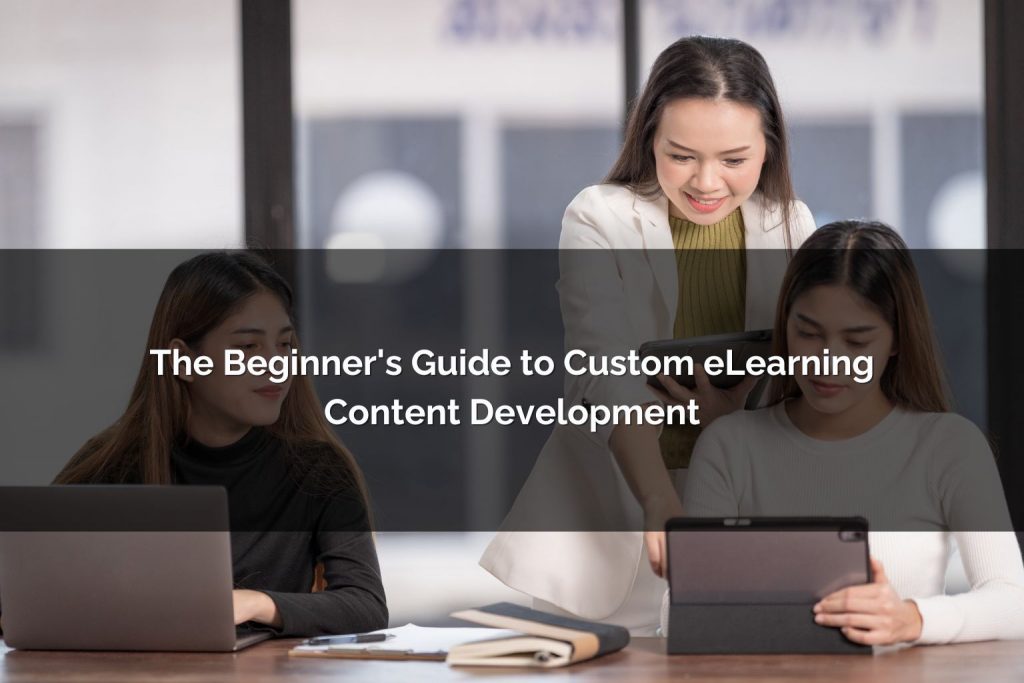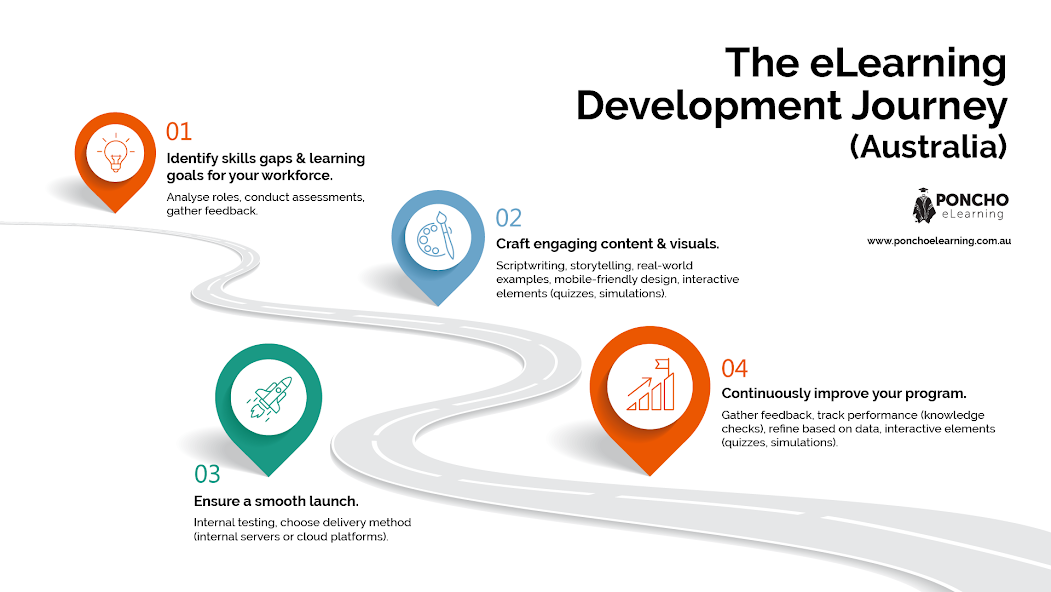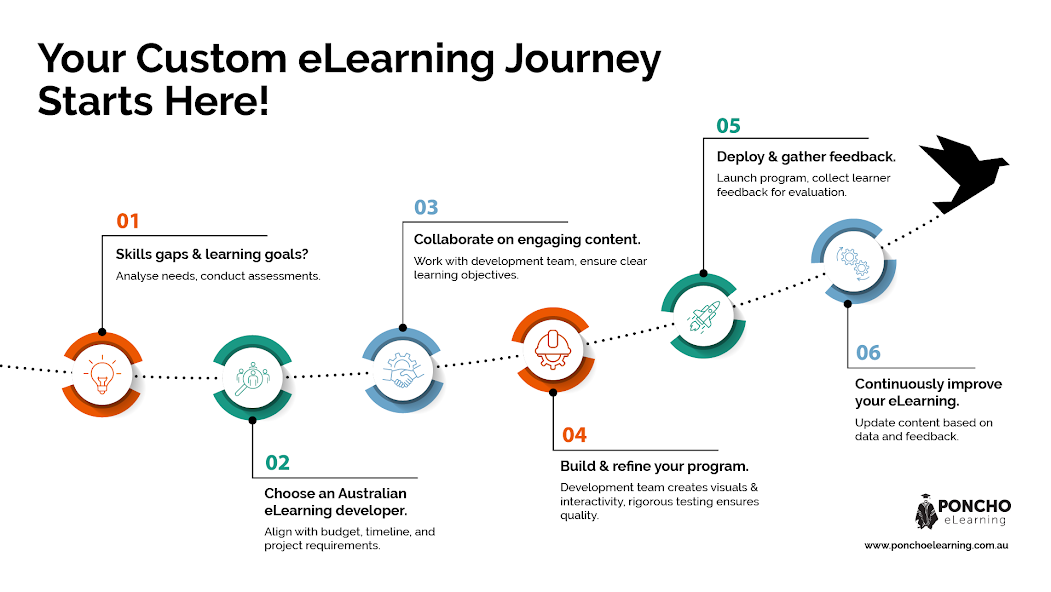Ever felt lost in the jungle of off-the-shelf eLearning solutions? While these generic programs might seem convenient, they often lack the personalisation and impact needed to truly engage your workforce. Custom eLearning content development is the answer! This guide equips you with the knowledge to navigate this exciting path and discover why it’s the perfect solution for your Australian business.

What is the process of eLearning content development?
The process typically involves a needs assessment, defining learning objectives, content creation, design and development, testing and deployment, and finally, evaluation and refinement.
Now, let’s delve deeper and explore the world of custom eLearning content development!
Why choose custom eLearning content development?
One-size-fits-all approaches rarely resonate in training. E-Learning content development allows you to tailor your training programs to the specific needs and goals of your Australian workforce. Here’s why you ought to think about using this strategy:
- Targeted Learning: Address the unique skills gaps and knowledge requirements of your employees, ensuring the training directly impacts their job performance.
- Engaged Learners: Custom content that reflects your company culture and uses real-life Australian workplace scenarios keeps learners hooked and motivated.
- Improved Knowledge Retention: Interactive elements, storytelling, and personalised learning experiences lead to better information retention compared to generic content.
- Measurable Results: Custom eLearning allows you to design assessments that accurately gauge if learners are acquiring the desired knowledge and skills.
- Compliance Assurance: Ensure your training programs adhere to relevant Australian regulations and industry standards.
Unveiling the Custom eLearning Content Development Process
Developing custom eLearning content might seem like a complex undertaking, but by breaking it down into manageable steps, you can create a program that delivers exceptional results. This is an outline of the usual procedure:

1. Needs Assessment:
The foundation of any successful eLearning program is a thorough understanding of your training needs. Here’s what you need to consider:
- Skills Gaps: Identify the knowledge and skill deficiencies within your workforce. Conduct skills assessments, analyse job roles, and gather feedback from managers and employees.
- Learning Objectives: Define the specific outcomes you want to achieve with the training program. What knowledge and skills should learners acquire by the end?
- Target Audience: Understanding your learners’ demographics, prior knowledge, and preferred learning styles is crucial for tailoring the content effectively.
2. Design and Development:
Once you’ve identified your needs, it’s time to bring your vision to life. Here’s where the magic happens:
- Content Scriptwriting: Develop engaging and informative content that aligns with your learning objectives. Use storytelling techniques, incorporate real-world Australian examples, and keep the language clear and concise.
- Visual Design: Visually appealing graphics, animations, and infographics enhance understanding and break up text-heavy content. Remember to optimise visuals for mobile learning, as many Australians access eLearning on their smartphones and tablets.
- Interactive Elements: Incorporate quizzes, polls, drag-and-drop activities, or simulations to keep learners engaged and actively participating in the learning process.
3. Testing and Deployment:
Before unleashing your masterpiece on the world, ensure it’s polished and functions flawlessly.
- Internal Testing: Conduct a pilot test with a small group of employees to identify any bugs, usability issues, or areas where the content can be improved.
- Deployment: Choose a suitable delivery method for your program. You can host the content on your internal servers or explore user-friendly cloud-based platforms.
4. Evaluation and Refinement:
The learning journey doesn’t end with deployment! Continuously monitor and evaluate the effectiveness of your eLearning program.
- Gather Feedback: Collect feedback from learners through surveys, focus groups, or one-on-one interviews. You can pinpoint areas for improvement thanks to this insightful input.
- Track Performance: While avoiding specifics related to data tracking, consider incorporating knowledge checks or assessments to gauge learning outcomes.
- Refine and Update: Based on feedback and performance data, refine your eLearning content to ensure it stays effective and relevant over time.
The Power of Storytelling in Custom eLearning Content Development
Storytelling is a powerful tool that can be harnessed in eLearning content development to create a more engaging and memorable learning experience. Here’s how:
- Captivate Learners: Stories tap into our emotions and make learning more relatable. By weaving narratives into your content, you can create a connection with learners and make the information more impactful.
- Enhance Knowledge Retention: Stories help learners process and retain information more effectively.
- Promote Active Learning: Stories can be used to frame scenarios or problems that learners need to solve, encouraging active participation and critical thinking.
- Reflect Company Culture: Weaving elements of your company culture and using Australian settings or references within your stories can further resonate with your workforce.
Here are some examples of how storytelling can be incorporated into custom e-Learning content development:
- Case Studies: Present real-world scenarios where employees have successfully applied the learned skills or knowledge.
- Branching Scenarios: Create interactive simulations where learners make choices that impact the story’s outcome, reinforcing decision-making skills.
- Historical Context: Use stories to illustrate the history or evolution of a concept relevant to the training content.
Unlocking the Potential of Custom eLearning Content Development with Australian Expertise
Custom e-Learning content development isn’t a one-size-fits-all solution, and that’s where the Australian expertise of a development partner comes in. Here’s why choosing a partner with a local understanding is crucial:
- Cultural Nuances: Australian workplaces have their own unique culture and communication styles. A development team familiar with the Australian context can create content that resonates better with your workforce.
- Regulatory Compliance: Australian training programs may need to adhere to specific industry regulations or national standards. A local partner can ensure your content aligns with these requirements.
- Real-World Examples: Using relevant Australian case studies, scenarios, and references makes the learning experience more relatable and engaging for your employees.
Getting Started with Custom eLearning Content Development: A Step-by-Step Guide

Ready to embark on your custom eLearning content development journey? Here’s a roadmap to guide you:
- Identify Your Needs: Conduct a thorough needs assessment to understand the skills gaps and learning objectives for your training program.
- Partner with an Australian eLearning Development Company: Choose a development partner with experience creating custom eLearning content for Australian businesses. Look for a company that aligns with your budget, timeline, and project requirements.
- Content Development and Design: Work collaboratively with the development team to create engaging and informative content that aligns with your learning objectives.
- Development and Testing: The development team will transform your content into a visually appealing and interactive eLearning program. Rigours testing ensures a smooth user experience.
- Deployment and Evaluation: Once testing is complete, deploy your eLearning program and gather feedback from learners to evaluate its effectiveness.
- Refine and Update: Based on feedback and performance data, refine your eLearning program to ensure it stays relevant and impactful over time.
Investing in Custom eLearning Content Development: A Smart Choice for Australian Businesses
Custom eLearning content development offers a multitude of benefits for Australian businesses. Here’s a quick recap:
- Improved Employee Engagement: Engaging and personalised content keeps learners motivated and fosters a positive learning environment.
- Enhanced Knowledge Retention: Interactive elements, storytelling, and targeted learning lead to better information retention compared to generic content.
- Measurable Results: Custom eLearning allows you to design assessments that accurately gauge if learners are acquiring the desired knowledge and skills.
- Increased Compliance: Ensure your training programs adhere to relevant Australian regulations and industry standards.
- Reduced Training Costs: Targeted training reduces the need for expensive in-person training sessions.
By investing in custom eLearning content development with a trusted Australian partner, you can empower your workforce, improve overall business performance, and gain a competitive edge in today’s dynamic market.
Ready to unlock the potential of custom eLearning? Contact a reputable Australian eLearning development company today and take the first step towards a more engaged and skilled workforce!




